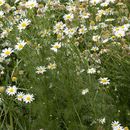en
names in breadcrumbs


The name Matricaria inodora var. agrestis Weiss was not validly published.
Tripleurospermum inodorum, common names scentless false mayweed,[1] scentless mayweed, scentless chamomile, wild chamomile, mayweed, false chamomile, and Baldr's brow, is the type species of Tripleurospermum. This plant is native to Eurasia and North Africa, and introduced to North America, where it is commonly found in fields, fallow land and gardens.[2]
Historically included the genus Matricaria, Tripleurospermum inodorum has been the subject of some controversy, with many revisions in recent years. The Flora Europaea uses Matricaria perforata for this species. Synonyms/other scientific names include Tripleurospermum perforatum (Mérat) Lainz, Tripleurospermum maritimum subsp. inodorum.
Pollen is collected by solitary bees.[7]
Ecological definition: Weed. Tripleurospermum inodorum has been classified as a noxious weed (class C) in the state of Washington and is considered invasive in other states (it is resistant to some herbicides); it is a weed of cereals in western Canada. W. L. Applequist (2002) has shown that the name Matricaria inodora is not a superfluous new name for M. chamomilla as earlier stated by S. Rauschert (1974). Therefore, the appropriate name under Tripleuro-spermum is T. inodorum. She also considered its type to belong in T. maritimum and formally recognized it there as subsp. inodorum, on the basis of hybridization with other T. maritimum subspecies (A. Vaarama 1953); on the same basis, however, Hämet-Ahti maintained the species distinction between T. inodorum and T. maritimum, while making T. phaeocephalum a subspecies of the latter. [8] According to Canadian regulations, it is classified as Secondary Noxious, Class 3 and Noxious, Class 5 in the Canadian Weed Seeds Order, 2016 under the Seeds Act.[9]
In Sweden and Norway, it is called Baldr's brow, but in Iceland, it is the close relative Sea Mayweed (Matricaria maritima) that carries this name.[11] In Gylfaginning, Snorri Sturluson explains that the name Balder's brow comes from the plants' whiteness:
Tripleurospermum inodorum, common names scentless false mayweed, scentless mayweed, scentless chamomile, wild chamomile, mayweed, false chamomile, and Baldr's brow, is the type species of Tripleurospermum. This plant is native to Eurasia and North Africa, and introduced to North America, where it is commonly found in fields, fallow land and gardens.
Historically included the genus Matricaria, Tripleurospermum inodorum has been the subject of some controversy, with many revisions in recent years. The Flora Europaea uses Matricaria perforata for this species. Synonyms/other scientific names include Tripleurospermum perforatum (Mérat) Lainz, Tripleurospermum maritimum subsp. inodorum.